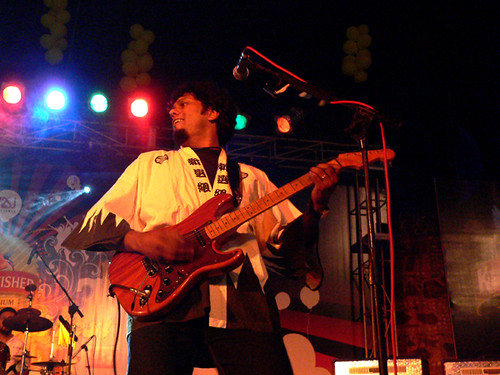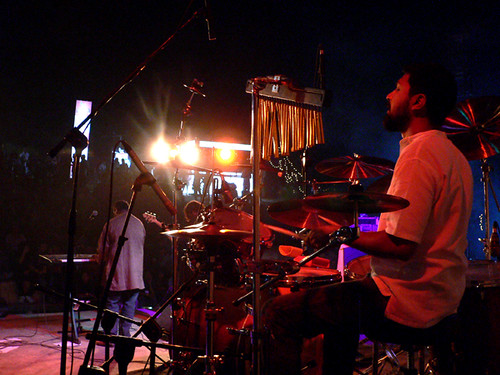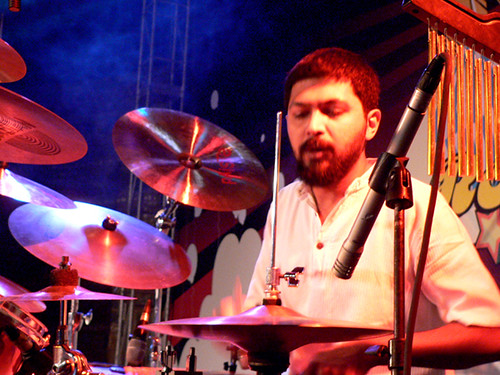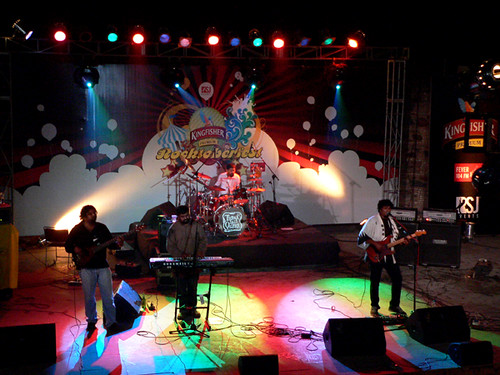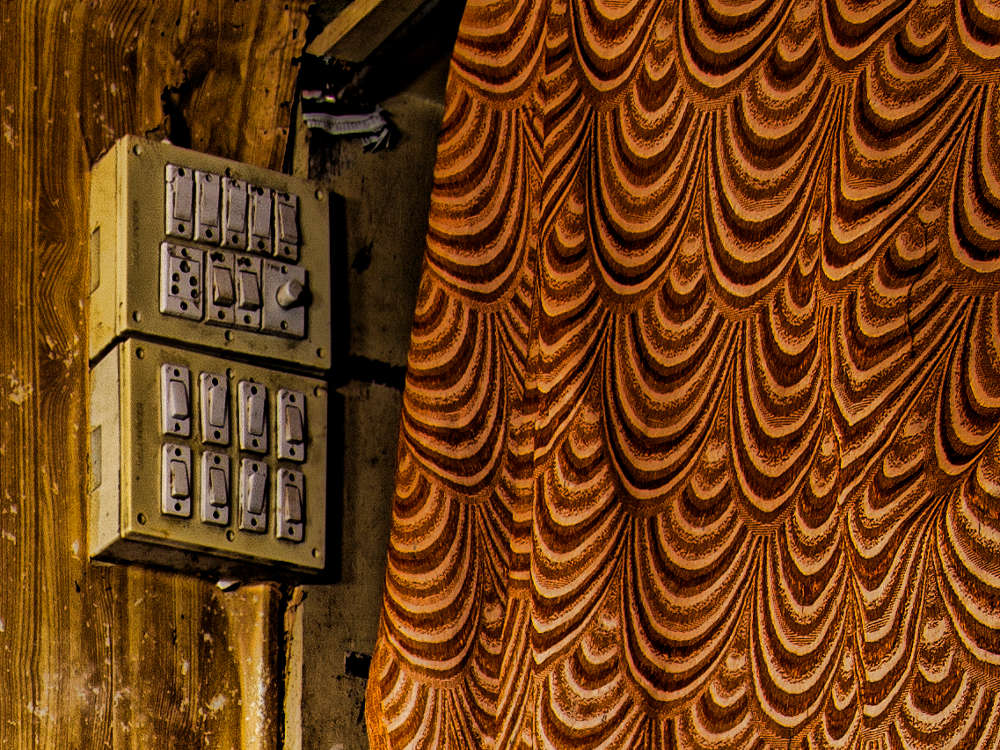After making their stash of funny money, the greasy-palmed triumvirate of Thermal And A Quarter have retired to their own private island. It’s a lavish life that many would envy, but for the ennui. They want to be entertained. So go ahead and make the most kickass music video for Kickbackistan, the song that made them filthy rich. And you could too if your video wins the 2 lakhs on offer for the Kick Out Corruption Music Video Competition. Go on, shoot!
-
-
Oct 21 – TAAQ & Swarathma at JD Rock Awards, Bangalore
TAAQ and Swarathma turn it on at the JD Rock Awards at Hard Rock Cafe, Bangalore on October 21.
Details here
-
-
Download Late O'Clock from our ReverbNation page!
Back in the day when we had a heavier prog-rock sound dominated by Bruce Eddie Shredder on lead guitar, Rajeev with the Alice in Chains cap on drums and the elemental Mr Sunil Chandienne on bass, we used to play this absolute crowd-immobilizer called Late O’Clock. We started performing it around 1997-8 and essayed it live as late as 2005.
If you haven’t ever heard of it, take a listen to this unreleased studio session from the taarchives.
The legend (for those who like to keep a tidy catalogue):
Late O’Clock (Instrumental)
Recorded 1997-98 @ Ebi Studios, Banaswadi, Bangalore
Personnel: Bruce Lee Mani: Guitar | Sunil Chandy: Bass | Rajeev Rajagopal: Drums | Bryan Richard: Rhythm GuitarYes, yes, we’re feeling generous. So, head to our ReverbNation page and download it. Just one thing — please don’t heckle us for lyrics.
-
-
Sankalp Khare's tee time with TAAQ
In the wee hours of September 8 Sankalp Khare, who had attended TAAQ’s gig at 10 Downing Street, Hyderabad, found himself trying on a tad-too-tiny TAAQ tee (note the alliteration). Aghast at the bikini-like fit, he vowed to have it exchanged. Or have his funny money back. Braving the terrors of the night he set out on an expedition to the hotel where the band was put up. Expecting hostility and badass band attitude at these odd hours, he made sure he came armed to the gills with some of his own. But quod erat demonstrandum, he mused as he rode home unscathed, “Luck comes hidden in the most unexpected things”.
Here’s Sankalp’s story in his own words…
The band and some friends were chilling at their hotel room when I arrived. It was great to meet them all and I’m quite sure I was acting mighty strange, trying to keep the excitement bottled up. Now I don’t know what you may have read about bands having attitude or ego issues or blah, but this was a group of fellers who made me feel at home almost instantly. Heck, the way Rajeev expressed his concerns about me riding all the way & back “all alone in the big bad city” would’ve reminded anyone of home! So after a teeny sip of what Rajeev was having and some chatter, someone (bless his soul!) said I should have a pic with my new TAAQ T-shirt. The way I’m looking like a 16-year-old kid on cloud 9 in the pic brings back some memories of Stillwater & the kid from Almost Famous. Bruce gave me a copy of “This is It” as a keepsake for my nightly visit.
-
-
Girls and boys, wear the new TAAQ logo!
If you want to look sharp in a future ThermalAndAQuarterly quiz, take note of this bit of trivia: The TAAQ logo came to be in 1999 when a certain brilliant graphic designer named Sivan (then taking a sabbatical from O&M before going solo) did us a generous albeit inspired favour. We remember staring at the artwork that leapt at us from the proof and simply begged to be smeared all over the world. We dutifully did as told.

When eleven years added wrinkles and adipose to the logo, Sivan decided it was time for a little botox job — a tuck here and a nip there. He sent us Version 2.0:
 We love it! In celebration, we have devised ways for you to flaunt it. Nope, not a tattoo — that’s Rajeev’s exclusive territory — but something more corporeal. It’s been ages since we let your bodies become advertising space — the last time was in 2003 (if you discount the “I’m with the band” crew tees issued by PG Santhosh in 2006).
We love it! In celebration, we have devised ways for you to flaunt it. Nope, not a tattoo — that’s Rajeev’s exclusive territory — but something more corporeal. It’s been ages since we let your bodies become advertising space — the last time was in 2003 (if you discount the “I’m with the band” crew tees issued by PG Santhosh in 2006).Here’s what our new tees look like:
Thanks to Sivan for the new logo, and to Kamal and Abhi of Pigflower for the excellent production. A very limited number of tees will be on sale at our Alliance Francaise gig on June 20. Come and get them!
-
Wha…?! Indian rock history minus TAAQ?!
Despite my own leanings, I cannot take seriously any article on the Indian rock music scene that dwells in the era of imitative cover performances, or performances of so-called originals that are so totally “inspired” by popular covers that they are no different from them at all. That stuff is so ten years ago. Maybe twenty. Without any vintage value whatsoever.
The “fascinating article” (by Arjun S Ravi on MTV Iggy) that Cicatrix speaks of in Sepia Mutiny reads like ‘The Best of RSJ (1992-1999), with Notable Exceptions’. It’s all been documented before with elan and sincerity by Amit Saigal. Today, it’s dated. Because it casually ignores a significant slice of Indian rock history — the independent music scene in Bangalore, which was where the really surprising stuff started to emerge from the mothballed closet in the late 1990s. In businesspeak, this era was when Indian rock music sought to “differentiate” itself. Not through marketing strategy (a la Parikrama et al which still have nothing to offer the discerning music fan) but through inventiveness, performance and startling creative energy. Ergo, I am not sure if Ravi’s omission stems from ignorance (which is unforgivable) or from personal bias (which is charlatan).
Thermal And A Quarter, as those who know their Indian indie scene know, began this revolution by playing entire three-hour sets comprising only originals — as early as 1999. No Indian band, repeat, no Indian band (save some in that fantastic cultural pocket — the Northeast) was doing that then. One other band that did it explosively — and I was witness to their memorable show at Madras Christian College’s Deep Woods in 1996 — was (then not-yet-Mumbai’s) Chakraview (with Dhruv Ghanekar on some serious gizmo-led guitar).
Perhaps Ravi also might want to remember that Laila Rouass-starring black-and-white music video, Colourblind, by the Mumbai band of the same name (the duo of Ram Sampath and Siddharth Achrekar). It was a brilliant new statement (very indie) and added a dimension to Indian rock that did not hitherto exist (or last). Sampath (now a composer for films and famous for his copyright victory over the Roshans for copying the music of Krazzy 4) told me off the record when I interviewed him (about Ram Madhvani’s Let’s Talk for Rediff.com in December 2002) that Colourblind “had not been viable”.
Viability has always been the gradient against which Indian indie rock has laboured. Indus Creed, after showing us the light, disappointed us by disbanding and resurfacing again as Alms for Shanti, with an eponymous album that was released both in English and Hindi (Kashmakash, Free Spirit, 2001). Alms for Shanti, with a name that sounded like it had been coined by an armchair Indologist at the University of Hawaii, plays the club circuit in New York where they have established themselves as export-reject exotics. Although singer Uday Benegal cribbed about the sleaze in the music industry as an aside during an interview with Rediff.com in 2002, he also told me this: “We went West because we were disillusioned with the East. Because the music we were doing at that time had absolutely no place here. Not that we were seeking salvation in the West. We wanted to go ahead with the music we make and look for the audience in the West.”
That’s one way to go, but if you know the audience to be here you have to be loyal to it. It must be remembered that around the same time that Alms for Shanti announced their album to a crowd of wine-sipping and tikka-nibbling celebs at a swank Tardeo lounge bar, a lot of bands that had been either influenced by TAAQ or shared the same struggle emerged from Bangalore — Kryptos, Myndsnare, Galeej Gurus, Zebediah Plush… And I am not even talking in any detail about the metal scene (which, being loud enough as it is, deserves an altogether different celebratory writeup amid a full-flowing headbangathon at Styx).
That TAAQ (still an unsigned band) was not from Bollywood-besotted Mumbai or Hindi-mein-gao-yaar Delhi or still-smoking-the-Sixties Kolkata was really what went against them when they started. Or the fact that their music was a leap year ahead of the public imagination — I mean, how many Benadryl-swillers orgasming in the moshpit had actually heard of (let alone heard) Steely Dan and Pat Metheny, or even imagined that they could influence an Indian band’s sound? The few critics of this counterculture — jealous jilted lovers of it mostly — judged the music by a myopic yardstick: the done-to-death genres of metal and dinosaur rock.
With Jupiter Cafe (2002), TAAQ’s second album, Bangalore shot into the limelight. It continued with Plan B (2004), the first album from India to be distributed with a custom Creative Commons-like license. These, inarguably, were milestones in Indian rock. Indie media (Indiecision, Split, RadioVerve… hell, even the un-indie Rolling Stone) acknowledged and celebrated them. MTV, which has always fed off the now happily moribund record industry (recently resuscitated by MJ’s passing) and now mooches off Bollywood to survive in the subcontinent, has no authority to comment on the indie scene. In the two fitful decades of Indian rock, MTV has neither recognised nor supported the indie movement. And to pay lip service to it now, with a limp biscuit such as this, is both embarrassing and shameful.
As the man who named his daughter Moon Unit said: “In the fight between you and the world, back the world.”
Part of this rant was originally posted as a comment on the muchly admired Sepia Mutiny
Photo: TAAQ from the back by SlickThief
Cross-posted from here
-







